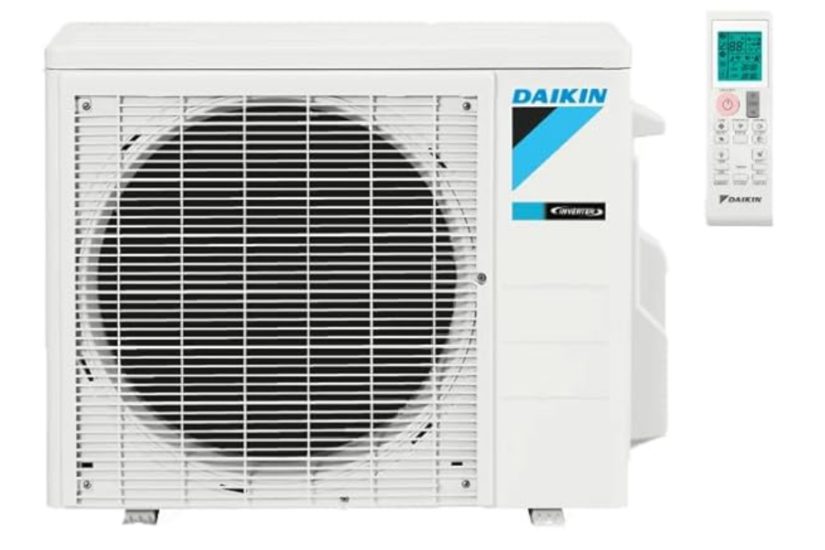
Bucket gardening is a simple way to grow plants in small spaces. Use buckets to grow herbs, veggies, or flowers. It saves space and makes gardening easy.
Choose buckets with holes for drainage. Fill them with good soil and plants. Water regularly and watch your garden grow.
Why try bucket gardening? It works for beginners and busy people. You can grow food or pretty plants anywhere.
Start with a few buckets and see what you can grow. Learn tips to make your plants healthy and happy. Get ready to enjoy fresh food and green space.
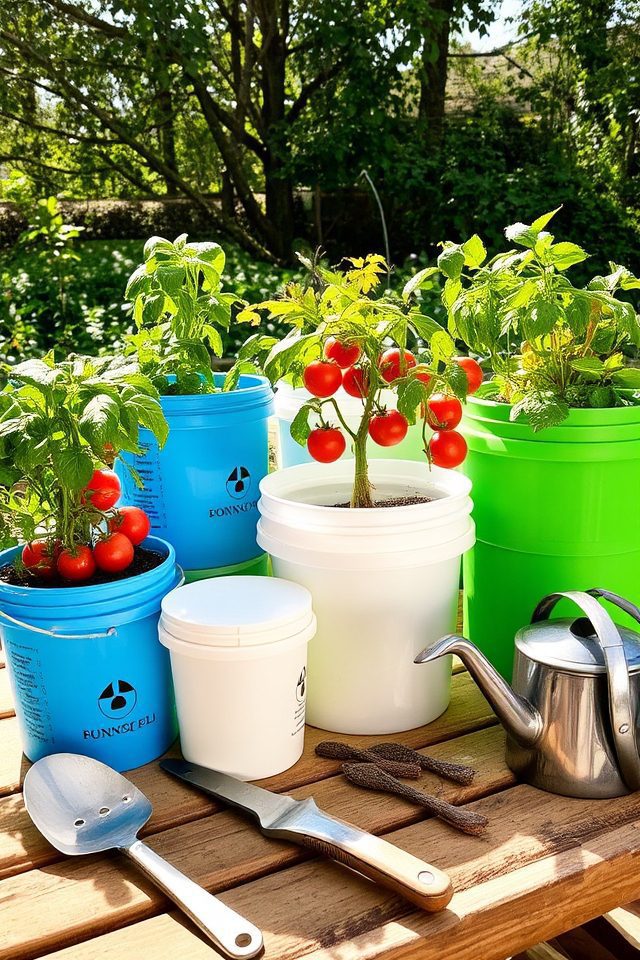
When selecting buckets for gardening, opt for food-grade plastic to guarantee that no harmful chemicals leach into your plants. A five-gallon bucket is ideal for many vegetables, providing ample room for roots to grow. Confirm the buckets have drainage holes at the bottom to prevent waterlogging, and consider the color; darker buckets heat up more, which can benefit certain plants in cooler climates. Remember to choose buckets that are easy to move and durable enough for outdoor conditions.
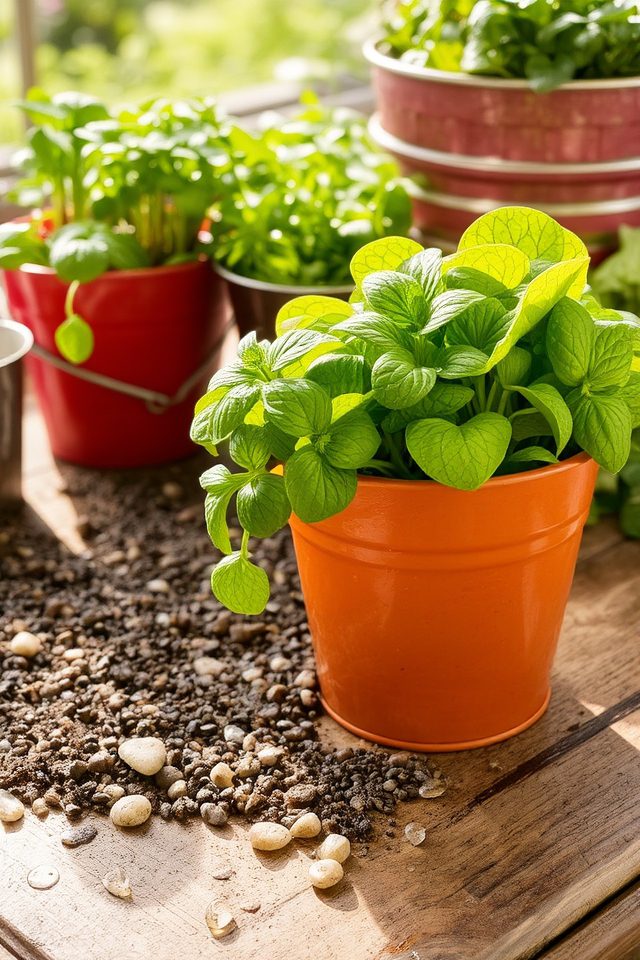
Guaranteeing proper drainage is essential for successful bucket gardening, as it prevents overwatering and root rot. To enhance drainage, use buckets with holes at the bottom to allow excess water to escape. Consider adding a layer of gravel or small stones before filling the bucket with soil, which will further promote drainage. Regularly check the moisture levels of the soil to verify that plants receive adequate water without becoming waterlogged.
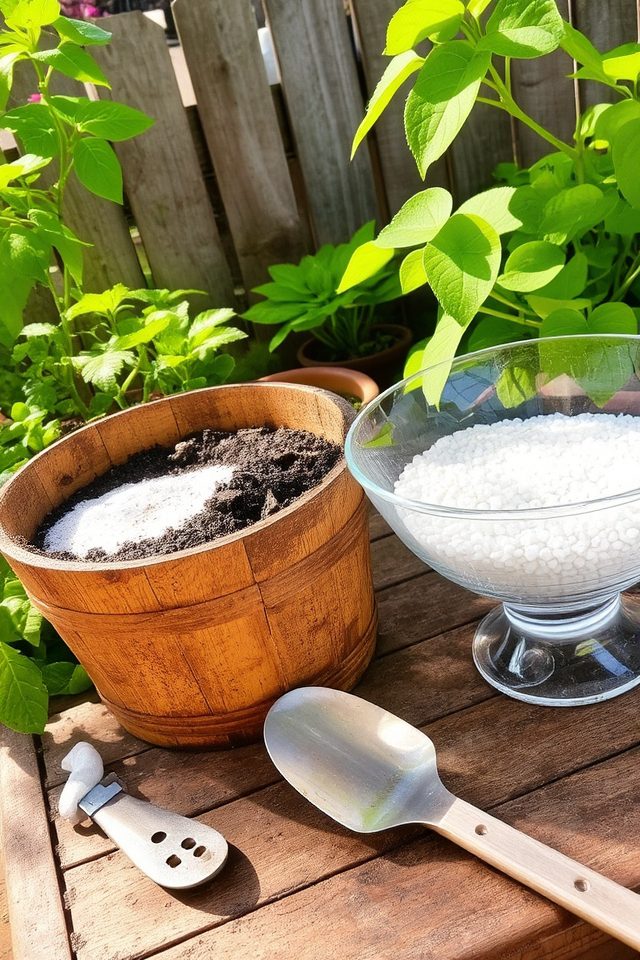
Choosing the right soil mix is essential for successful bucket gardening. A good mix should provide adequate drainage, aeration, and nutrients. Combine equal parts of potting soil, compost, and perlite or vermiculite for a well-balanced blend. This combination guarantees that water drains effectively while retaining enough moisture and nutrients for plant growth. Additionally, consider adding organic fertilizers to enrich the soil and support healthy plant development throughout the growing season.
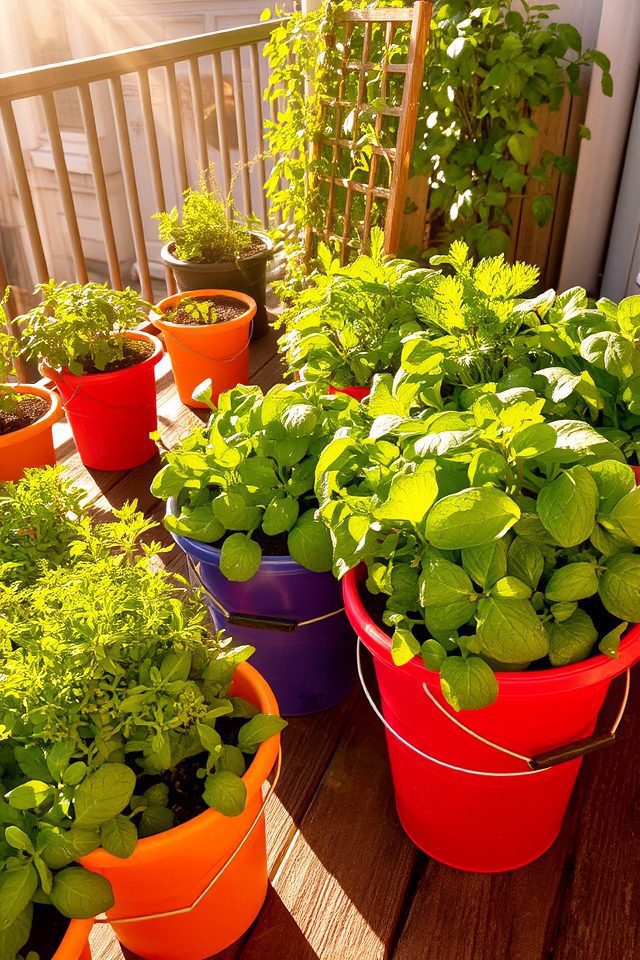
To enhance sunlight exposure for bucket gardening, position your buckets in a location that receives at least 6-8 hours of direct sunlight daily. If space is limited, consider rotating the buckets throughout the day to guarantee even exposure. Additionally, selecting reflective surfaces or materials around your garden can help bounce light onto the plants. Keep an eye on your plants, as signs of leggy growth may indicate they need more light for best health and productivity.
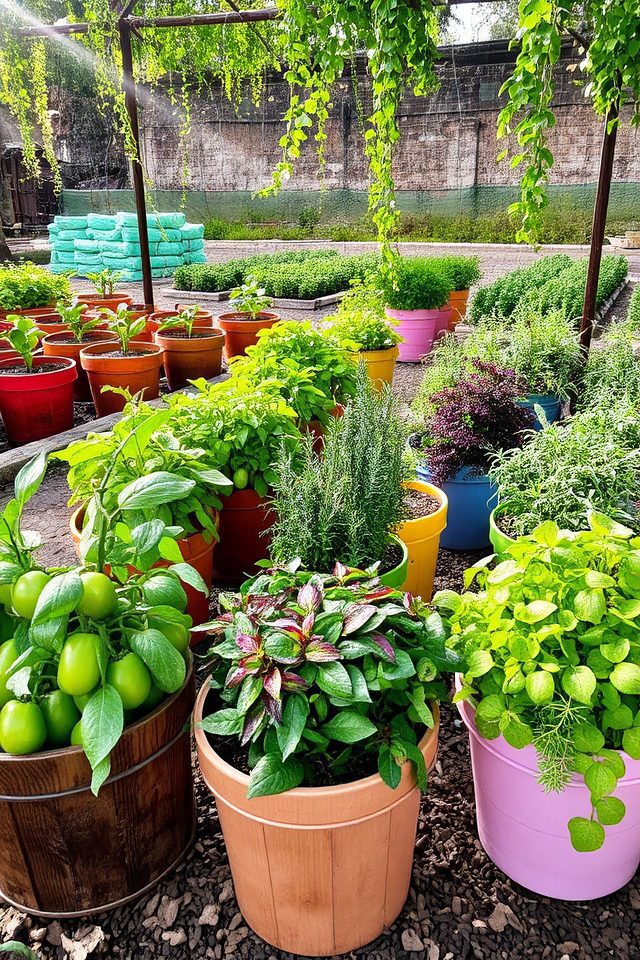
When planning your planting layout for bucket gardening, consider the size and depth of your containers, as well as the specific needs of each plant. Group plants with similar sunlight and water requirements to guarantee peak growth. Use a combination of larger buckets for deep-rooted vegetables and smaller ones for herbs or shorter plants. Arrange buckets in a way that maximizes space and accessibility, allowing you to easily tend to each plant while creating an aesthetically pleasing garden.
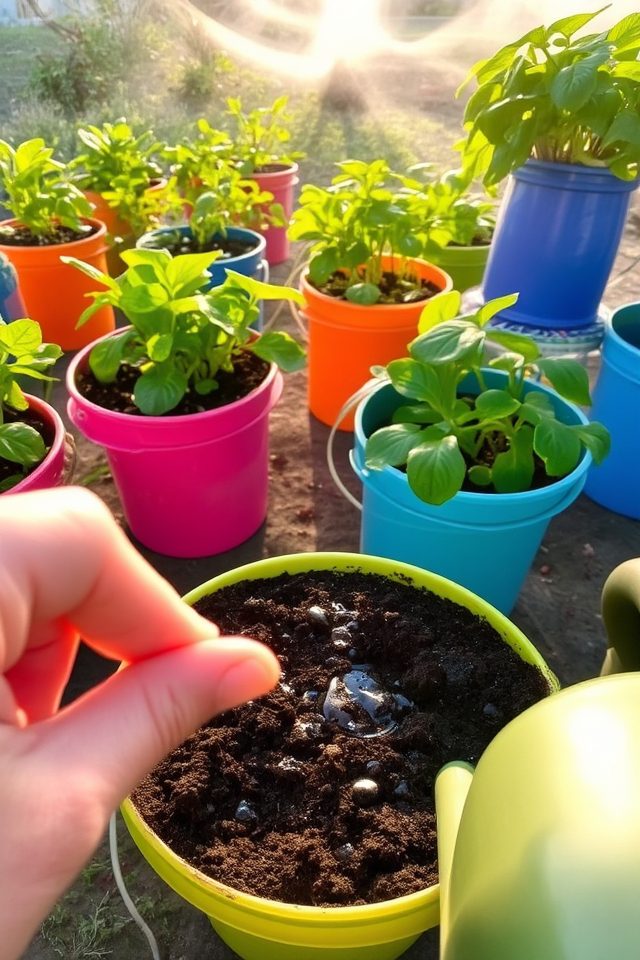
Watering your bucket garden wisely is essential for healthy plant growth. Make sure you water early in the morning or late in the evening to minimize evaporation. Containers can dry out quickly, so check the moisture level regularly by sticking your finger an inch into the soil. Use a drip irrigation system or self-watering buckets if possible, as these methods provide consistent moisture without over-saturating the plants. Adjust watering frequency based on weather conditions and plant needs.
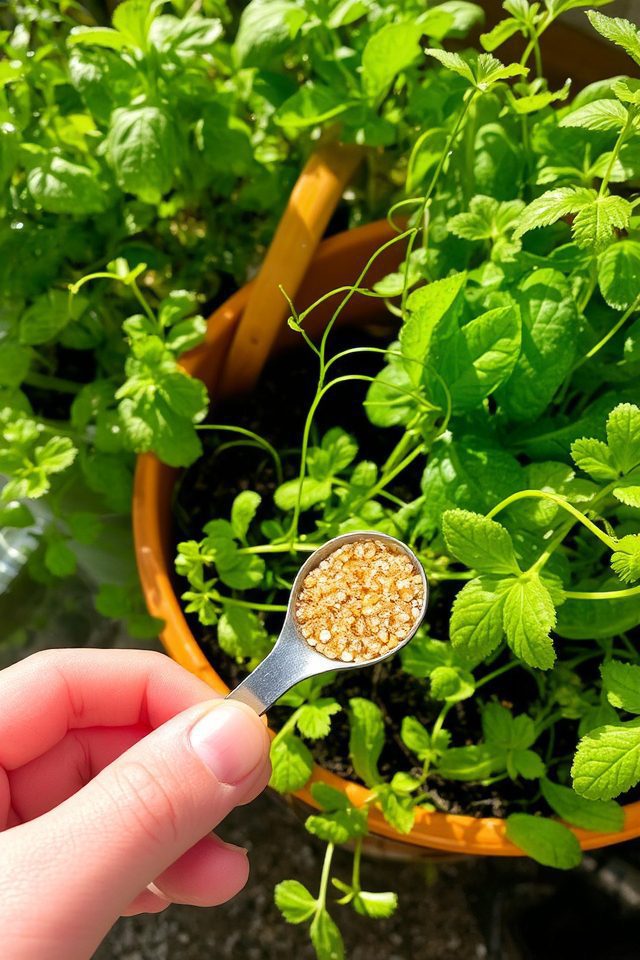
Fertilizing regularly is essential for maintaining healthy plants in bucket gardening. As container plants have limited soil and nutrients, they rely on you to provide the necessary sustenance. Choose a balanced, water-soluble fertilizer and apply it every 4-6 weeks during the growing season. Be sure to follow package instructions to avoid over-fertilization, which can harm your plants. Observing your plants’ growth and adjusting the feeding schedule accordingly will help guarantee vibrant, thriving greenery.
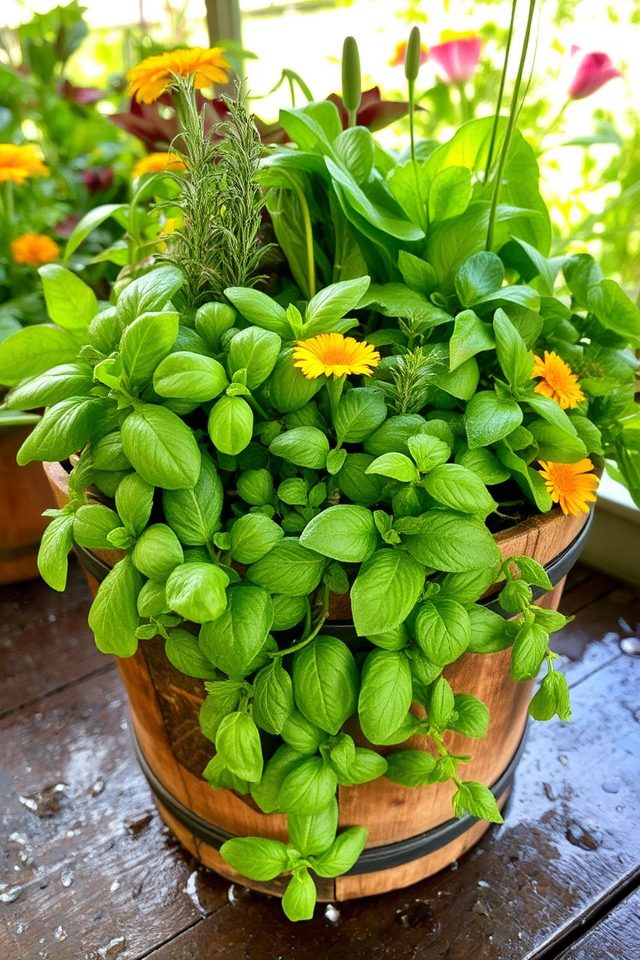
Mixing and matching plants in your bucket garden can create a vibrant and diverse growing environment. Choose complementary plants that have similar light and water needs, such as combining herbs like basil with salad greens. This not only maximizes space but also helps deter pests naturally. Layering different heights and colors can enhance visual appeal, while incorporating companion plants boosts growth and flavor. Experiment with various combinations to discover unique pairings that thrive together!
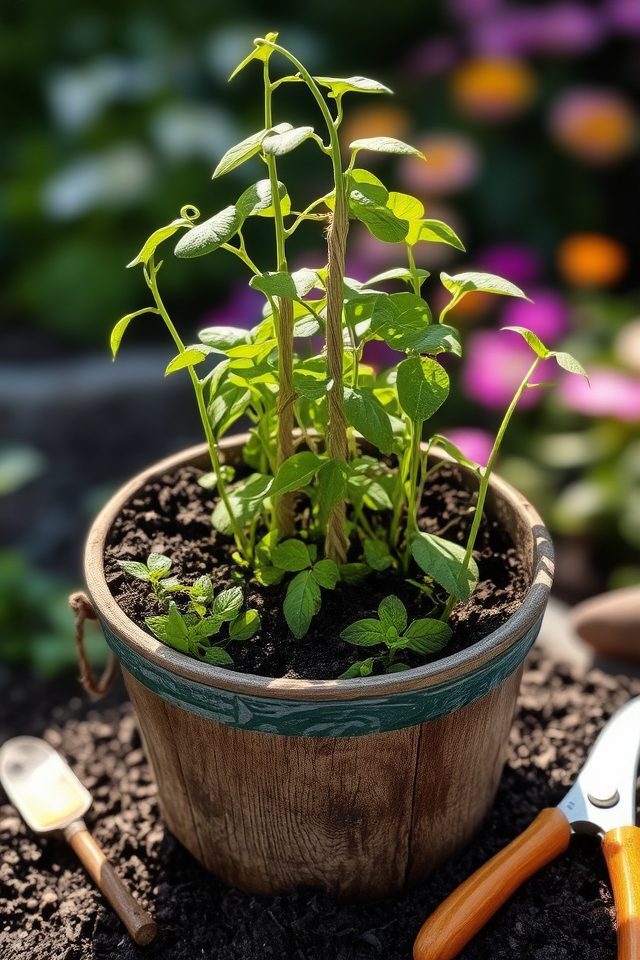
Supporting climbing plants in a bucket garden is essential for their growth and stability. Utilize trellises, stakes, or garden netting to give these plants the vertical space they crave. Position the support structures in the bucket before planting, ensuring they are securely anchored. As the plants grow, gently guide them towards the support, which will help improve air circulation, prevent disease, and maximize sunlight exposure, ultimately leading to a healthier, more productive garden.
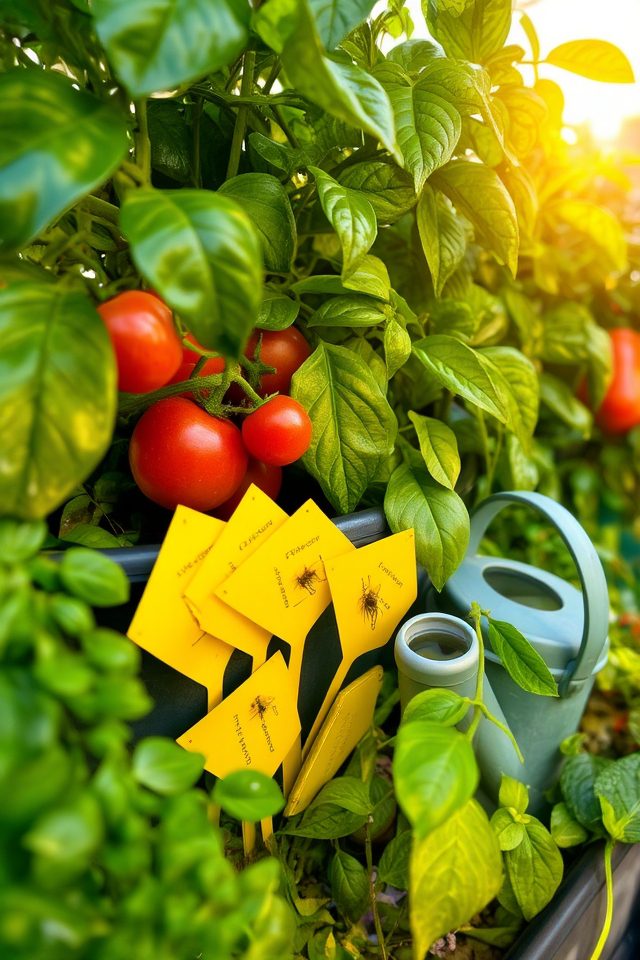
Monitoring for pests in your bucket garden is essential for maintaining healthy plants. Regularly inspect your plants for signs of insect activity, such as holes in leaves or sticky residue. Consider using yellow sticky traps to catch flying pests and check the undersides of leaves for eggs or tiny insects. If you spot any infestations, identify the pests and choose an appropriate method for control, whether it’s natural remedies or organic pesticides, to protect your garden’s health.
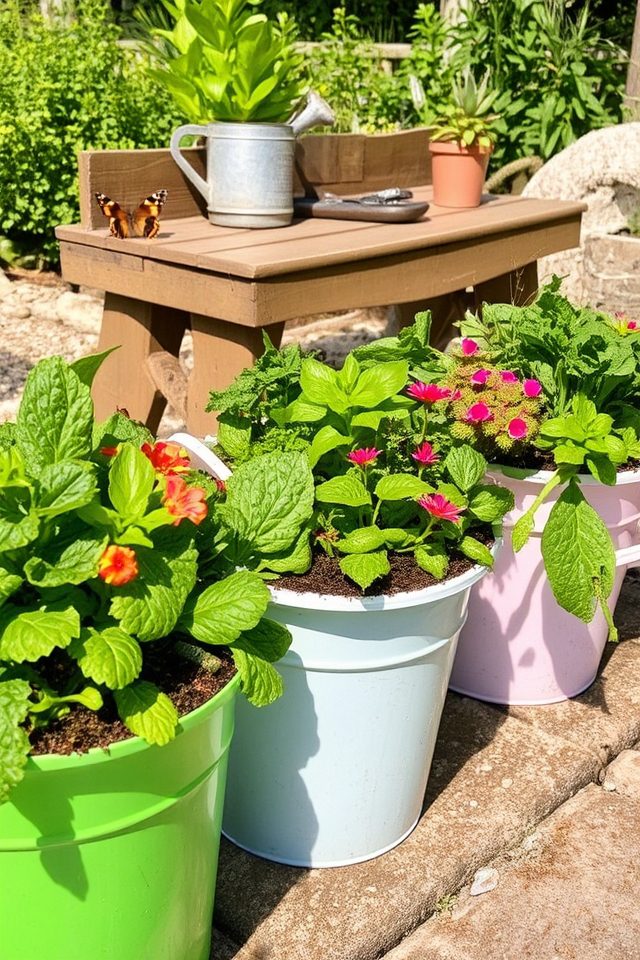
Rotating your crops in bucket gardening is essential for maintaining soil health and preventing pest and disease buildup. By changing the location of your plants each growing season, you disrupt the life cycles of pests and reduce soil nutrient depletion. Aim to follow a crop rotation schedule, where you alternate plant families in each bucket. This practice not only enhances your garden’s productivity but also encourages a diverse ecosystem, leading to healthier plants overall.
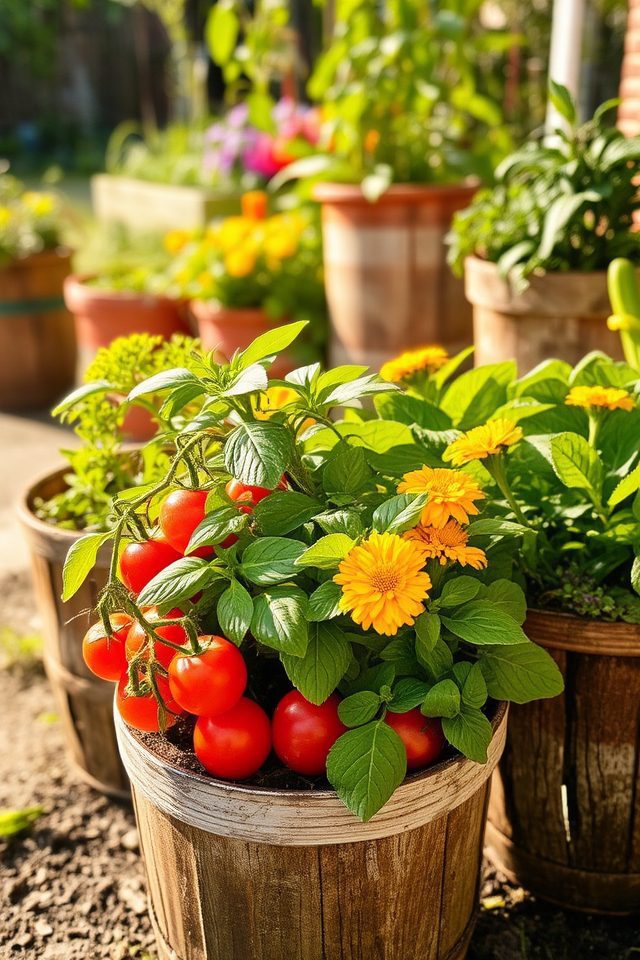
Companion planting is a gardening technique that involves pairing plants that benefit each other when grown together. In bucket gardening, this practice maximizes space and improves plant health. For instance, pairing basil with tomatoes can enhance flavor and deter pests. Similarly, planting marigolds near vegetables can repel harmful insects. By considering companion planting, gardeners can create a harmonious environment that fosters growth, yields healthier plants, and reduces the need for chemical treatments.
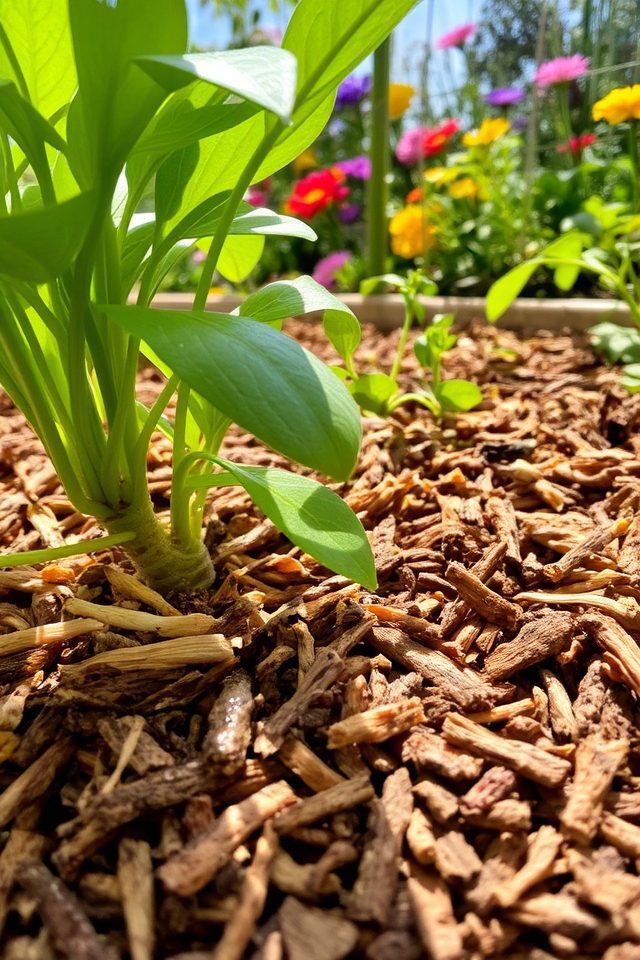
Mulch is an essential component in bucket gardening, particularly for moisture retention. By applying a layer of organic mulch, such as straw, wood chips, or shredded leaves, you can considerably reduce evaporation from the soil surface, keeping your plants hydrated for longer periods. Additionally, mulch helps regulate soil temperature and suppresses weeds, allowing your plants to thrive with minimal competition for nutrients and moisture. Regularly replenishing your mulch will guarantee peak garden health.
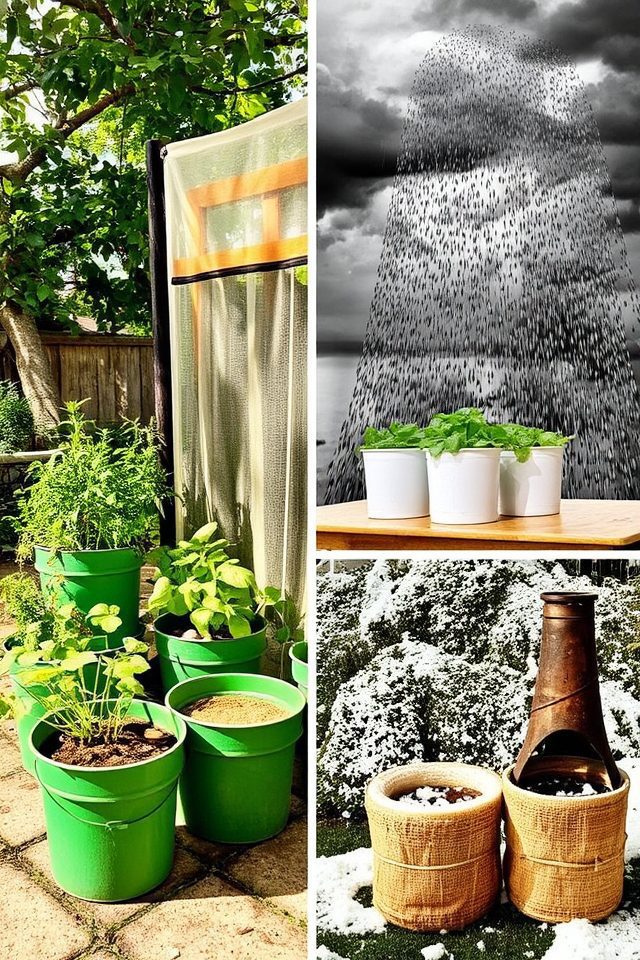
Protecting your bucket garden from extreme weather is essential for maintaining healthy plants. In hot weather, consider moving your buckets to a shaded area during the hottest part of the day or using shade cloth to reduce sun exposure. During heavy rain or storms, make certain your buckets have proper drainage to prevent root rot. For cold temperatures, you can wrap the buckets with insulation or bring them indoors during frost warnings to keep your plants safe.
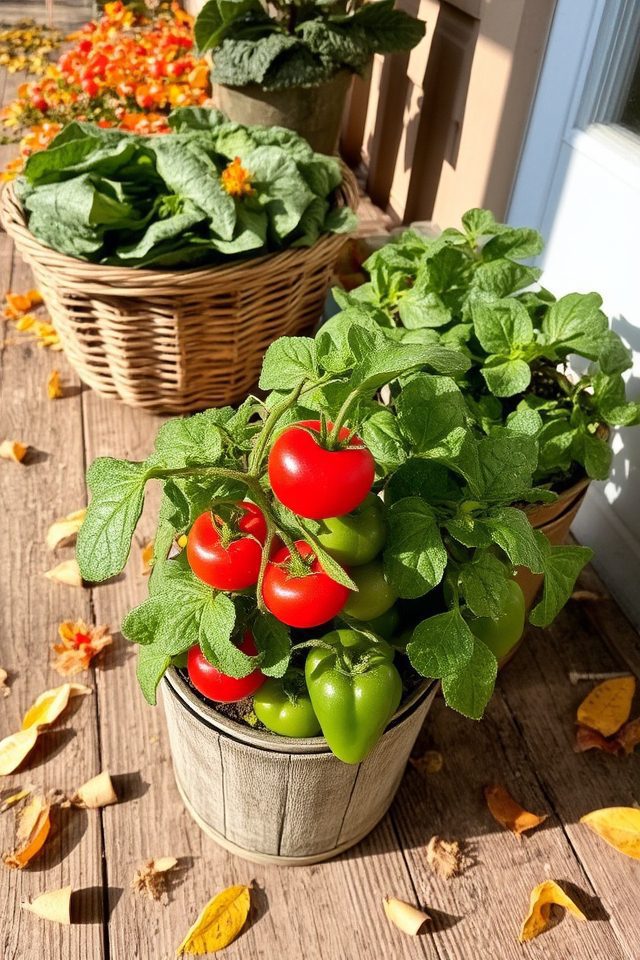
As the seasons change, so do the needs of your bucket garden. During spring and summer, opt for vibrant, heat-loving plants like tomatoes and peppers. As fall approaches, shift to cooler crops such as kale and spinach. In winter, consider using insulated buckets or moving hardy plants indoors to protect them from frost. Always monitor soil moisture and adjust watering as temperatures fluctuate, ensuring a thriving garden year-round.
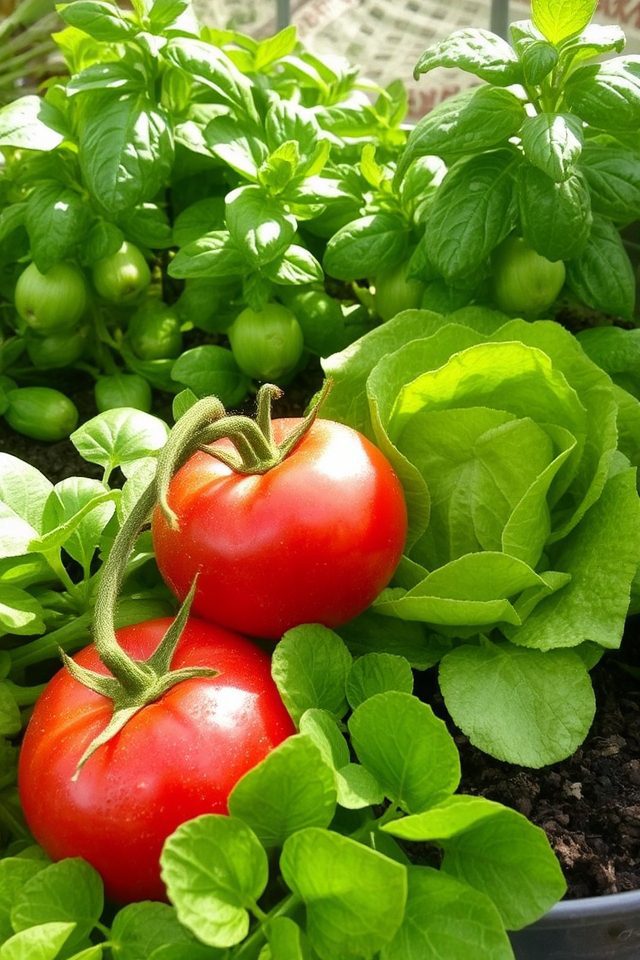
Harvesting at the right time is essential for maximizing the flavor, texture, and nutritional value of your fruits and vegetables in a bucket garden. Different plants have specific signs that indicate when they are ripe; for example, tomatoes should be fully colored and slightly firm, while leafy greens like lettuce should be harvested before they bolt. Regularly checking your plants helps guarantee you pick them at their peak, leading to a more enjoyable and successful gardening experience.
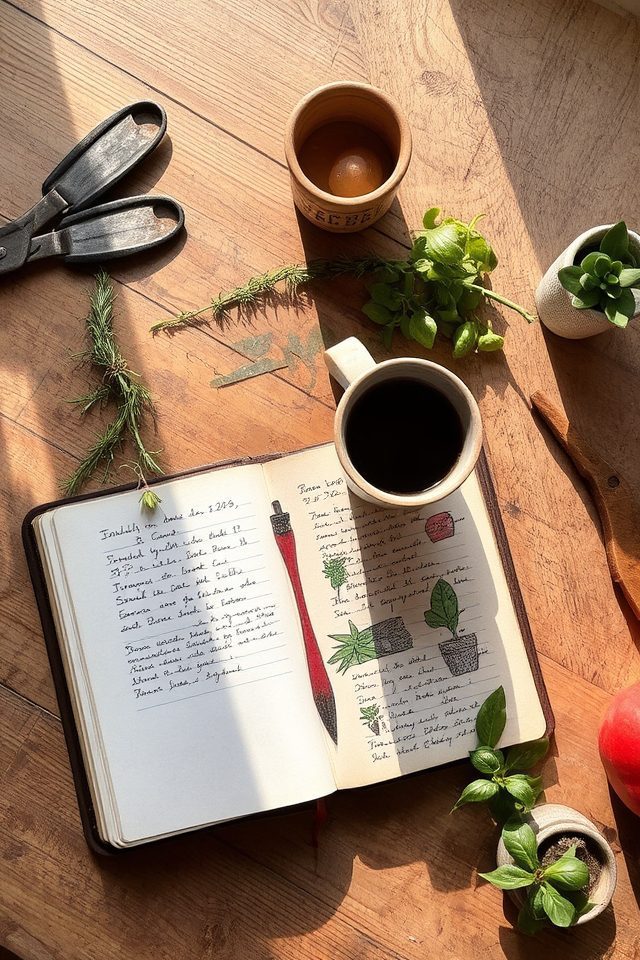
Keeping a gardening journal is an invaluable practice for any gardener, especially for those engaged in bucket gardening. Documenting your planting dates, growth progress, weather conditions, and any challenges faced allows you to track the success of your efforts over time. Additionally, a journal serves as a creative outlet where you can sketch designs or jot down new ideas. By reflecting on previous seasons, you can make informed decisions, improve your gardening skills, and enhance the productivity of your bucket garden.
By following these bucket gardening tips, you’ll cultivate a thriving container garden that brings joy and nourishment. Think of your garden as a well-tuned orchestra—each element contributes to a harmonious whole. Just as a conductor guarantees every musician plays in sync, you’ll need to manage soil, water, and plants with care. With a bit of diligence and creativity, your bucket garden can flourish, providing a symphony of flavors and colors right at your fingertips. Happy gardening!

Don't let aphids, slugs, and caterpillars ruin another plant. Take back control with simple, natural methods that actually work.